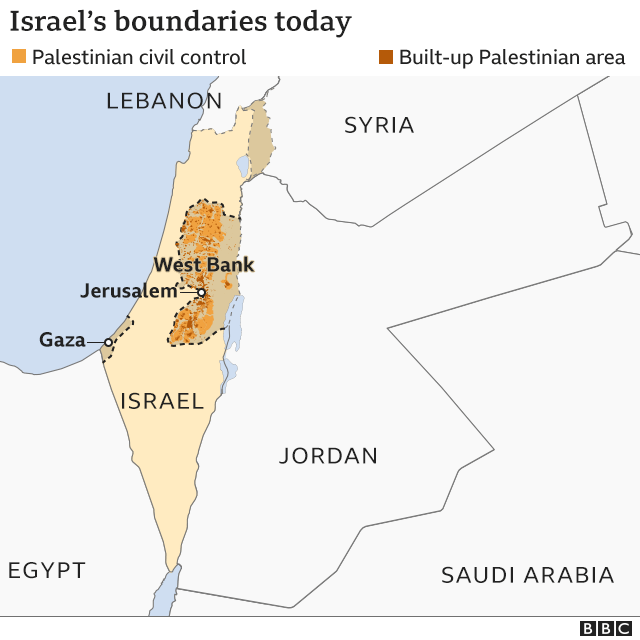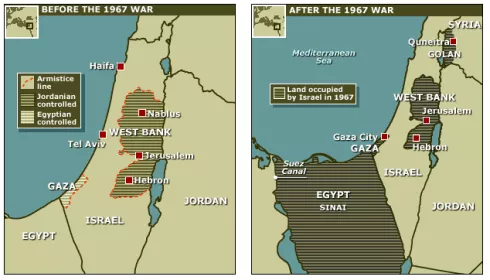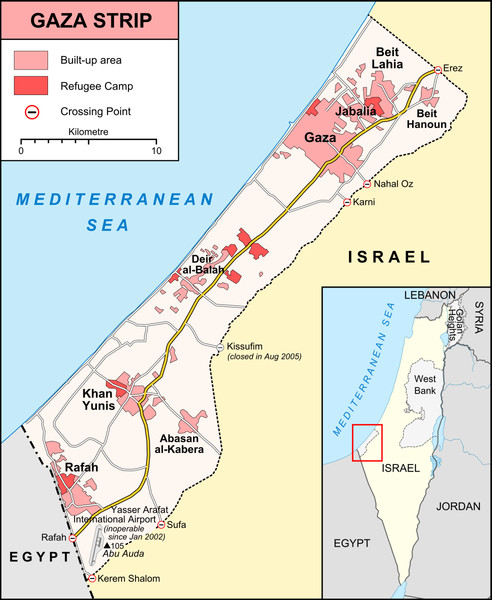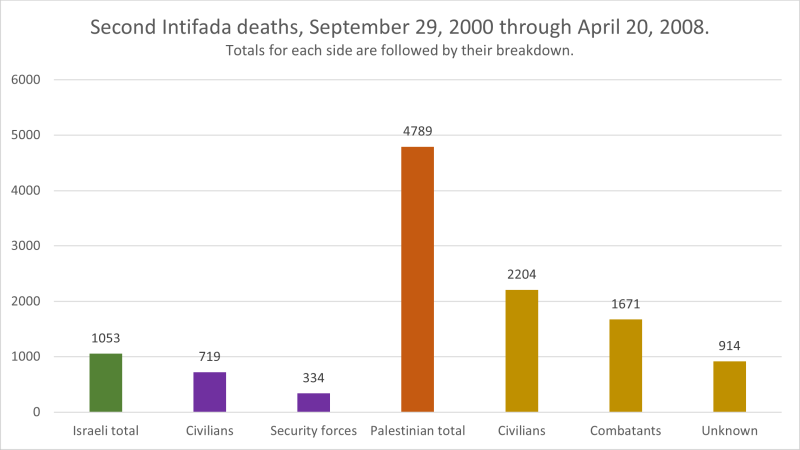Israel and Palestine : A Preliminary Background
A Bit of History

Israel is the world’s only Jewish state, located just east of the Mediterranean Sea. Palestinians, the Arab population that hails from the land Israel now controls, refer to the territory as Palestine, and want to establish a state by that name on all or part of the same land. The Israeli-Palestinian conflict is over who gets what land and how it’s controlled.
Though both Jews and Arab Muslims date their claims to the land back a couple thousand years, the current political conflict began in the early 20th century. Jews fleeing persecution in Europe wanted to establish a national homeland in what was then an Arab- and Muslim-majority territory in the Ottoman and later British Empire. The Arabs resisted, seeing the land as rightfully theirs. An early United Nations plan to give each group part of the land failed, and Israel and the surrounding Arab nations fought several wars over the territory. Today’s lines largely reflect the outcomes of two of these wars, one waged in 1948 and another in 1967.
The 1967 war is particularly important for today’s conflict, as it left Israel in control of the West Bank and Gaza Strip, two territories home to large Palestinian populations:

Today, the West Bank is nominally controlled by the Palestinian Authority and is under Israeli occupation. This comes in the form of Israeli troops, who enforce Israeli security restrictions on Palestinian movement and activities, and Israeli “settlers,” Jews who build ever-expanding communities in the West Bank that effectively deny the land to Palestinians. Gaza is controlled by Hamas, an Islamist fundamentalist party, and is under Israeli blockade but not ground troop occupation.
The primary approach to solving the conflict today is a so-called “two-state solution” that would establish Palestine as an independent state in Gaza and most of the West Bank, leaving the rest of the land to Israel. Though the two-state plan is clear in theory, the two sides are still deeply divided over how to make it work in practice.
The alternative to a two-state solution is a “one-state solution,” wherein all of the land becomes either one big Israel or one big Palestine. Most observers think this would cause more problems than it would solve, but this outcome is becoming more likely over time for political and demographic reasons.
https://www.vox.com/2018/11/20/18080002/israel-palestine-conflict-basics.
How Israel became a country

Jews often trace their nationhood back to the biblical kingdoms of David and Solomon, circa 950 BC. Modern Zionism began in the 19th century — right about the time that nationalism started to rise in Europe. Zionism is a nationalist political ideology that called for the creation of a Jewish state, and now supports the continued existence of Israel as such a state, building on the longstanding Jewish yearning for a “return to Zion.” A secular Austrian-Jewish journalist, Theodor Herzl, was the first to turn rumblings of Jewish nationalism into an international movement around 1896.
Herzl witnessed brutal European anti-Semitism firsthand, and became convinced the Jewish people could never survive outside of a country of their own. He wrote essays and organized meetings that spurred mass Jewish emigration from Europe to what’s now Israel/Palestine. Before Herzl, about 20,000 Jews lived there; by the time Adolf Hitler came to power in Germany, the number was about eight times that.
Social and political developments in Europe convinced Jews they needed their own country, and their ancestral homeland seemed like the right place to establish it. European Jews — 90 percent of all Jews at the time — arrived at Zionism partly because of rising anti-Semitic persecution and partly because the Enlightenment introduced Jews to secular nationalism. Between 1896 and 1948, hundreds of thousands of Jews resettled from Europe to what was then British-controlled Palestine, including large numbers forced out of Europe during the Holocaust.
Many Arabs saw the influx of Jews as a European colonial movement, and the two peoples fought bitterly. The British couldn’t control the violence, and in 1947 the United Nations voted to split the land into two countries. Almost all of the roughly 650,000 Jews went to the blue territory in the map to the right, and a majority of the Arab population (roughly twice the size of the Jewish community) went to the orange.
The Jewish residents accepted the deal. The Palestinians, who saw the plan as an extension of a long-running Jewish attempt push them out of the land, fought it. The Arab states of Egypt, Jordan, Iraq, and Syria all later declared war on Israel, as well (albeit not to defend the Palestinians).
Israeli forces defeated the Palestinian militias and Arab armies in a vicious conflict that turned 700,000 Palestinian civilians into refugees. The UN partition promised 56 percent of British Palestine for the Jewish state; by the end of the war, Israel possessed 77 percent — everything except the West Bank and the eastern quarter of Jerusalem (controlled by Jordan), as well as the Gaza Strip (controlled by Egypt). It left Israelis with a state, but not Palestinians.
https://www.vox.com/2018/11/20/18080010/zionism-israel-palestine, and
How did Israel become a country in the first place?. Vox.com, 14 May 2018, https://www.vox.com/2018/11/20/18080016/israel-zionism-war-1948
Gaza

Gaza is a densely populated strip of land that is mostly surrounded by Israel and peopled almost exclusively by Palestinians. Israel used to have a military presence, but withdrew unilaterally in 2005. It’s currently under Israeli blockade.
The sporadic rocket fire that’s hit Israel from there since its pullback has strengthened Israeli hawks’ political position, as they have long argued that any Palestinian state would end up serving as a launching pad for attacks on Israel.
Egypt controlled Gaza until 1967, when Israel occupied it (along with the West Bank) in the Six-Day War. Until 2005, Israeli military authorities controlled Gaza in the same way they control the West Bank, and Jews were permitted to settle there. In 2005, then–Israeli Prime Minister Ariel Sharon pulled out Israeli troops and settlers unilaterally.
Gaza is governed by the Islamist group Hamas, which formed in 1987 as a militant “resistance” group against Israel and won political power in a 2006 US-based election. Hamas’s takeover of Gaza prompted an Israeli blockade of the flow of commercial goods into Gaza, on the grounds that Hamas could use those goods to make weapons to be used against Israel. Israel has eased the blockade over time, but the cutoff of basic supplies like fuel still does significant humanitarian harm by cutting off access to electricity, food, and medicine.
Hamas and other Gaza-based militants have fired thousands of rockets from the territory at Israeli targets. Israel has launched a number of military operations in Gaza, including an air campaign and ground invasion in late 2008 and early 2009, a major bombing campaign in 2012, and another air/ground assault in the summer of 2014.
https://www.vox.com/2018/11/20/18080046/gaza-palestine-israel.
The Intifadas

The intifadas were two Palestinian uprisings against Israel, the first in the late 1980s and the second in the early 2000s. The intifadas had a dramatic effect on Israeli-Palestinian relations; the second, in particular, is widely seen as marking the end of the 1990s era negotiating process and ushering in a new, darker era in Israeli-Palestinian relations.
The first intifada was a largely spontaneous series of Palestinian demonstrations, nonviolent actions like mass boycotts and Palestinians refusing to work jobs in Israel, and attacks (using rocks, Molotov cocktails, and occasionally firearms) on Israelis. Palestinian fatalities dramatically outpaced Israeli ones, as the Israeli military responded to the protests and attacks with heavy force.
The second, and far bloodier, intifada grew out of the collapse of the peace process in 2000. Negotiations between Israeli Prime Minister Ehud Barak and PLO Chairman Yasser Arafat broke down, and the intifada began shortly afterwards. Typically, Israelis blame a conscious decision by Arafat to turn to violence for the intifada’s onset, while Palestinians point to an intentionally provocative visit to the contested Temple Mount by Israeli politician (and soon to be Prime Minister) Ariel Sharon. While both Arafat and Sharon played some part, the central cause was likely a basic mistrust between the two sides that made war inevitable after peace talks broke down.
The spark that lit this powder keg was a series of Palestinian demonstrations that Israeli soldiers fired on. Palestinian militants subsequently escalated to broader violence, and the PA refused to rein them in.
Unlike with the first intifada, Palestinian tactics centered on suicide bombings, rocket attacks, and sniper fire — which Israel met with even deadlier force. The conflict petered out in 2005, but not before about 1,000 Israelis and 3,200 Palestinians were killed.
The second intifada, together with the wave of rocket fire from Gaza after the Hamas takeover, had a transformative effect on Israeli attitudes toward the conflict. The Israeli peace camp’s traditional argument, that Israel would be eventually rewarded for trading land for peace, became significantly less popular. Skepticism of the peace process grew, complicating future efforts to arrive at a two-state agreement.
https://www.vox.com/2018/11/20/18080066/israel-palestine-intifadas-first-second.